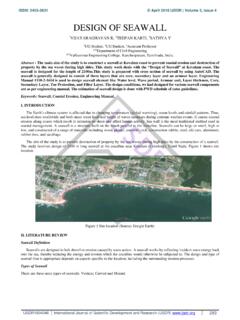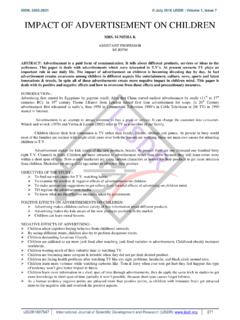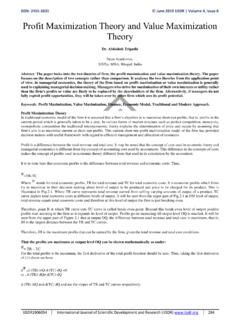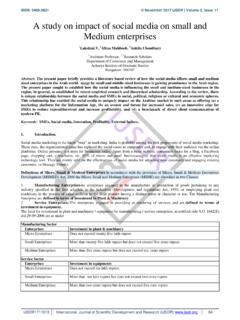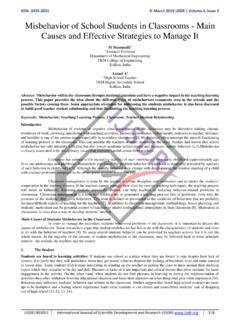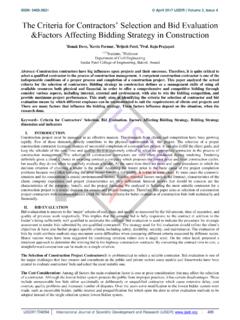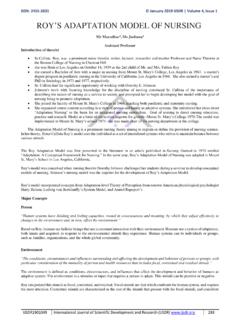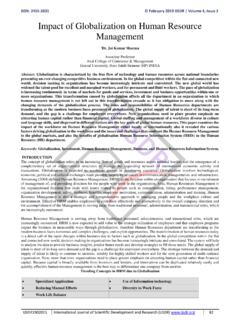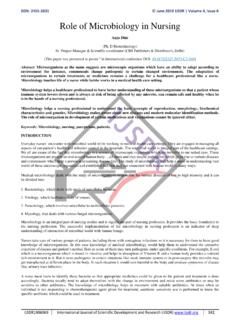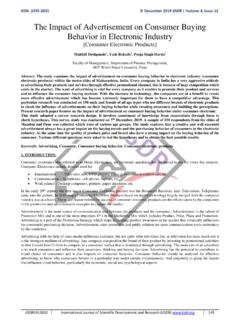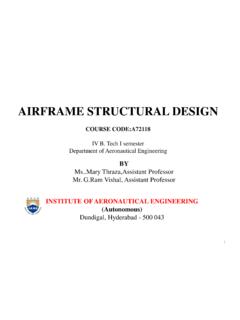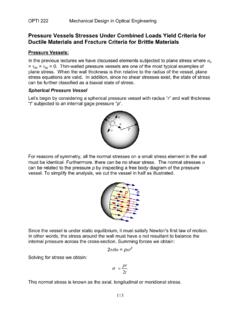Transcription of Design, Modelling and Manufacturing aspects of Honeycomb ...
1 ISSN: 2455-2631 April 2017 IJSDR | Volume 2, Issue 4 IJSDR1704101 International Journal of Scientific Development and Research (IJSDR) 526 design , Modelling and Manufacturing aspects of Honeycomb Sandwich Structures: A Review 1 Shubham V. Rupani, 2 Shivang S. Jani, 1PG scholar, 2 Assistant Professor, 3 Principal Mechanical engineering department Atmiya Institute of Technology and Science, Rajkot, Gujarat, India. Abstract: Honeycomb sandwich panels are widely used in automobile, aerospace and space structures due to unique characteristics like high strength to weight ratio and High stiffness. Honeycomb sandwich panels consist of Honeycomb core made of either metal or thin paper like materials.
2 Core is sandwiched with metallic or composite face sheets. Core gives high compressive strength in T direction whereas face sheet gives shear strength in T and W direction. Compressive strength of sandwich panel depends on foil thickness of Honeycomb core, cell size, thickness of core in T direction and face sheet thickness. For nearly same weight Honeycomb sandwich panels can give up to 30 times higher stiffness than metallic sheets. Face sheets of the sandwich structure facilitate mounting of the instruments as core has very high volume fraction of cavity and hence cannot hold fasteners of Honeycomb sandwich structures with actual cell configuration is difficult and time consuming. Hence sandwich structure is generally modeled as equivalent homogeneous structure.
3 This paper gives an insight about design , simulation and Manufacturing aspects of Honeycomb sandwich structures. Keywords: Honeycomb panel, thin walled structure, sandwich structureI. INTRODUCTION The Honeycomb structure is a type of cellular materials with regular and periodically repeated arrays of hexagonal cells and it is composed of two thin, stiff, strong sheets serving as primary load carrying elements and thick layer of low density core providing shear resistance and stiffness. [1,2] Honeycomb has wide range of applications such as aerospace, shipbuilding, vehicle, construction, energy absorber, thermal isolators, packaging etc. Some of the unique characteristics which makes Honeycomb structure a preferred choice for these applications are high stiffness to weight ratio, elimination of welding, superior insulation quality and design versatility.
4 [3] a. HISTORY Honeycomb consist of arrays of cells formed from thin sheets of material. Mostly the cells are hexagonal but there are also other cell configurations like square and flex core. Some variations of these configurations are the over-expanded, under-expanded and reinforced. Honeycomb was first made from paper around 2000 years ago and it was used for ornaments by Chinese people. In 1919 first time aircraft primary structure was fabricated with sandwich panel made of thin mahogany facings bonded to end grain balsa wood core. Later between World War I and World War II, plywood skins and balsa wood core was used for aircraft structures by Italians. The manufacture of structural honeycombs began in late 1930s.
5 In 1945 first aluminum sandwich panel was produced. Then with the development of better adhesives it was possible to achieve good bonding strength to the face sheets. Initially made adhesives had very high amount of volatile contents which can cause problem due to outgassing when used at temperature above 100 C. Hence initially core to be used in aerospace and space structures were kept perforated. Modern adhesives are purely solid and does not contain volatiles. Hence core Manufacturing and curing is simplified.[4] Figure 1 : Sandwich Construction b. TERMINOLOGY The following are some basic terms commonly used for Honeycomb structures.[4] ISSN: 2455-2631 April 2017 IJSDR | Volume 2, Issue 4 IJSDR1704101 International Journal of Scientific Development and Research (IJSDR) 527 Figure 2 : Honeycomb Terminology Honeycomb density : the weight of one cubic meter of core expressed in kilograms (kg/m3) or pounds per cubic feet (pcf) Cell : a single Honeycomb unit Cell size: distance between two opposite sides of hexagonal cell.
6 Ribbon : the flat sheet material constituting the Honeycomb Node: the bonded portion of adjacent ribbon sheets. Free wall: cell wall sections of single bonded sheets. Foil thickness : thickness of free wall L direction : the core ribbon direction W direction : the core expansion direction T direction: the core direction parallel with cell openings. Honeycomb Before Expansion (HOBE): the solid block of bonded sheets. c. Characteristics of Honeycomb sandwich There are some applications were light weight is a design criteria and usage of thin sheets causes buckling problem due to concentrated loads. In such applications Honeycomb panels should be used. If the loads acting are very high then thick skins are required.
7 In table 1 some of the standard structural panel constructions are compared for relative strength and stiffness. Table 1 : Comparison of structural panels Structural panel construction Relative strength Relative stiffness Honeycomb sandwich 100% 100% Foam sandwich 26% 68% Structural extrusion 62% 99% Sheet and stringer 64% 86% Plywood 3% 17% Honeycomb works as energy absorbing material as it crushes uniformly at known load and has highest crush strength to weight ratio of all energy absorbing materials. Aluminum Honeycomb is widely used in common energy absorption applications. Stainless steel Honeycomb is used for high temperature application such as nuclear power plants.[5] For mechanical structures which undergo repeated loads, fatigue properties of the core has to be investigated.
8 Cell dimensions core density have significant influence on the fatigue strength.[6-9] II. TYPES OF Honeycomb The most common Honeycomb are aluminum, Nomex, fiberglass and Kraft paper. However Honeycomb can be manufactured from almost any thin sheet materials. The nonmetallic cores are resin dipped in phenolics, polyamide (for high temperatures), ISSN: 2455-2631 April 2017 IJSDR | Volume 2, Issue 4 IJSDR1704101 International Journal of Scientific Development and Research (IJSDR) 528 epoxy and thermoplastics (for toughness) corrugated aluminum Honeycomb core Manufacturing process is more time consuming than expansion method; hence the corrugated core is usually more expensive.
9 Aluminum Honeycomb is made of corrugation process because above 192 kg/m3 (12pcf) it becomes very difficult to expand the HOBE. If strength and modulus requirement is very high in L direction, then reinforced cell configuration is used. Reinforcements can increase strength up to 35 MPa. If corrugated slice is roll formed in W direction then sometimes nodes are separated. In such cases staggering can be done as shown in R2S configuration in figure 3. Instead of each ribbon node contacting the entire opposite node, they are offset.[4] Normal Hexagon (R1) Reinforced every other ribbon (R2) Reinforced every ribbon (2R2) Double reinforced every ribbon (R2S) Reinforced every ribbon staggered Figure 3 : Corrugated cell configurations Hexagon Reinforced hexagon Over expanded Square cells Under expanded Flex core Figure 4 : Honeycomb cell configurations a.
10 CELL CONFIGURATIONS The most common cell shapes are hexagon, square and flex core. Some variations of these configurations are overexpanded, underexpanded and reinforced. The hexagonal cell shape is most common for adhesively bonded Honeycomb and mostly resistance welded and brazed cores have square cells. The over expanded core allows to form cylinder in L direction. Hex cores does not easily form to curved shapes and must be roll formed or heat formed. Flex core is used when Honeycomb must be formed with compound curves as this configuration can be wrapped around spherical shape as small as baseball.[4] If Honeycomb cells are irregular in shape with uniform wall thickness then modulus increases considerably while Poisson s ratios are insignificantly affected.
